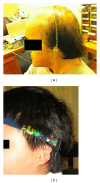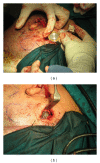Contemporary hearing rehabilitation options in patients with aural atresia
- PMID: 24883324
- PMCID: PMC4022278
- DOI: 10.1155/2014/761579
Contemporary hearing rehabilitation options in patients with aural atresia
Abstract
Congenital aural atresia is the failure of development of the external auditory canal. It usually occurs in conjunction with microtia, which is the malformation of the auricle due to a failure of development of the external ear. Aural atresia, with or without microtia, may significantly affect the hearing and social life of the patients. It is important for every medical practitioner to be aware of the possible treatment options for hearing rehabilitation in this group of patients. In the era of modern technology, new choices, including Bone-Anchored Hearing Aid (BAHA) (Cochlear Ltd. and Oticon Medical), Vibrant Soundbridge (VSB) (MED-EL, Innsbruck, Austria), and Bonebridge system (BB) (MED-EL, Innsbruck, Austria), provide high-end alternatives to traditional Bone Conduction Hearing Aid and Auditory Canal Reconstruction. All these options have advantages and disadvantages, and they are appropriate for different patients and/or at different ages. This paper aims to provide an overview of the management of hearing rehabilitation in congenital aural atresia patients and a discussion of each treatment option.
Figures











Similar articles
-
Surgery or implantable hearing devices in children with congenital aural atresia: 25 years of our experience.Int J Pediatr Otorhinolaryngol. 2015 Jul;79(7):975-9. doi: 10.1016/j.ijporl.2015.03.031. Epub 2015 Apr 10. Int J Pediatr Otorhinolaryngol. 2015. PMID: 25930173
-
Auricular reconstruction using Medpor combined with different hearing rehabilitation approaches for microtia.Acta Otolaryngol. 2021 Jun;141(6):572-578. doi: 10.1080/00016489.2021.1900601. Epub 2021 Apr 6. Acta Otolaryngol. 2021. PMID: 33823748
-
Congenital aural atresia: bone-anchored hearing aid vs. external auditory canal reconstruction.Int J Pediatr Otorhinolaryngol. 2012 Feb;76(2):272-7. doi: 10.1016/j.ijporl.2011.11.020. Epub 2011 Dec 15. Int J Pediatr Otorhinolaryngol. 2012. PMID: 22177319
-
Atresiaplasty in Congenital Aural Atresia: What the Facial Plastic Surgeon Needs to Know.Facial Plast Surg Clin North Am. 2018 Feb;26(1):87-96. doi: 10.1016/j.fsc.2017.09.005. Facial Plast Surg Clin North Am. 2018. PMID: 29153191 Review.
-
Congenital aural atresia.J Craniofac Surg. 2013 Jul;24(4):e418-22. doi: 10.1097/SCS.0b013e3182942d11. J Craniofac Surg. 2013. PMID: 23851888 Review.
Cited by
-
A Bone Conduction Implantable Device as a Functional Treatment Option in Unilateral Microtia with Bilateral Stapes Ankylosis: A Report of Two Cases.Am J Case Rep. 2018 Jan 23;19:82-89. doi: 10.12659/ajcr.904907. Am J Case Rep. 2018. PMID: 29358571 Free PMC article.
-
Guideline "Implantable hearing aids"-short version : German S2k guideline of the Working Group of German-Speaking Audiologists, Neurootologists and Otologists (ADANO), of the German Society of Oto-Rhino-Laryngology, Head and Neck Surgery (DGHNO) in collaboration with the German Society of Audiology (DGA), the German Society of Phoniatrics and Pediatric Audiology (DGPP), and patient representatives.HNO. 2018 Jul;66(Suppl 2):71-76. doi: 10.1007/s00106-018-0533-2. HNO. 2018. PMID: 30259069 English. No abstract available.
-
Cartilage Conduction Hearing Aids in Clinical Practice.Audiol Res. 2023 Jul 13;13(4):506-515. doi: 10.3390/audiolres13040045. Audiol Res. 2023. PMID: 37489381 Free PMC article. Review.
-
Hearing Aid Uptake in Children with Unilateral Microtia and Canal Atresia: A Comparison between a Tertiary Center and Peripheral Centers.J Int Adv Otol. 2020 Apr;16(1):73-76. doi: 10.5152/iao.2020.5509. J Int Adv Otol. 2020. PMID: 32401206 Free PMC article.
-
Comparative Analysis of Cartilage Conduction Hearing Aid Users and Non-Users: An Investigative Study.Audiol Res. 2023 Jul 27;13(4):563-572. doi: 10.3390/audiolres13040049. Audiol Res. 2023. PMID: 37622925 Free PMC article.
References
-
- Kelley PE, Scholes MA. Microtia and congenital aural atresia. Otolaryngologic Clinics of North America. 2007;40(1):61–80. - PubMed
-
- El-Begermy MA, Mansour OI, El-Makhzangy AMN, El-Gindy TS. Congenital auditory meatal atresia: a numerical review. European Archives of Oto-Rhino-Laryngology. 2009;266(4):501–506. - PubMed
-
- Bouhabel S, Arcand P, Saliba I. Congenital aural atresia: bone-anchored hearing aid vs. external auditory canal reconstruction. International Journal of Pediatric Otorhinolaryngology. 2012;76(2):272–277. - PubMed
-
- Siegert R, Mattheis S, Kasic J. Fully implantable hearing aids in patients with congenital auricular atresia. The Laryngoscope. 2007;117(2):336–340. - PubMed
-
- Scholtz AW, Fish JH, III, Kammen-Jolly K, et al. Goldenhar’s syndrome: congenital hearing deficit of conductive or sensorineural origin? Temporal bone histopathologic study. Otology and Neurotology. 2001;22(4):501–505. - PubMed
Publication types
MeSH terms
Supplementary concepts
LinkOut - more resources
Full Text Sources
Other Literature Sources
Medical

